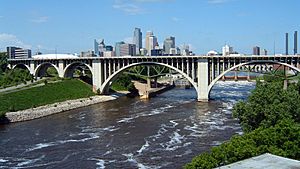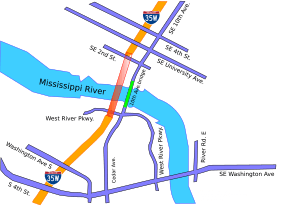10th Avenue Bridge facts for kids
Quick facts for kids 10th Avenue Bridge |
|
|---|---|

The 10th Avenue Bridge in Minneapolis
|
|
| Coordinates | 44°58′42″N 93°14′38″W / 44.9784°N 93.2438°W |
| Carries | Four lanes of automobile traffic |
| Crosses | Mississippi River |
| Locale | Minneapolis, Minnesota |
| Maintained by | Minneapolis |
| ID number | 2796 |
| Characteristics | |
| Design | Concrete rib deck-arch bridge |
| Total length | 2,175 feet (663 m) |
| Width | 68 feet (21 m) |
| Longest span | 266 feet (81 m) |
| Clearance below | 101 feet (31 m) |
| History | |
| Opened | 1929 |

Bridges over the Mississippi in Minneapolis–St. Paul. 10th Ave Bridge is in green, about center on this image, between Collapsed I-35 Bridge in shadow red and Washington Ave. Bridge.
|
|
|
Cedar Avenue Bridge
|
|
| Location | Tenth Ave. over Mississippi River, Minneapolis, Minnesota |
|---|---|
| Area | 4 acres (1.6 ha) |
| Built | 1929 |
| Architect | Oustad, Kristoffer Olsen |
| Architectural style | Reinforced-concrete bridge |
| MPS | Reinforced-Concrete Highway Bridges in Minnesota MPS |
| NRHP reference No. | 89001845 |
| Added to NRHP | November 6, 1989 |
The 10th Avenue Bridge is a cool bridge that crosses the mighty Mississippi River. You can find it near downtown Minneapolis, Minnesota, and it's also close to the University of Minnesota. This bridge helps people get from 10th Avenue Southeast on one side of the river to 19th Avenue South on the other.
Before the I-35W bridge was built, this bridge was known as the Cedar Avenue Bridge. It used to connect to Cedar Avenue. The 10th Avenue Bridge is a very important structure. It was designed by a talented engineer named Kristoffer Olsen Oustad. He was one of four famous Norwegian-American men who designed big buildings and bridges in the area.
This bridge was added to the National Register of Historic Places in 1989. This means it's recognized as a special historical place. It also marks the start of the Saint Anthony Falls Historic District downstream. After the I-35W bridge had problems, the 10th Avenue Bridge was closed for a short time. Later, it reopened and became a popular spot to see the recovery efforts.
Building the Bridge
The construction of the 10th Avenue Bridge started in 1926. It took three years to build and was finished in 1929. The bridge is very long, measuring about 2,175 feet (663 meters) in total. It has two main sections in the middle, each stretching 265.5 feet (80.9 meters) across.
Design and Materials
The bridge has a special design called an "open spandrel" arch. This means it has open spaces in the arch structure, making it look lighter. It's made from reinforced concrete, which is concrete with steel bars inside to make it extra strong.
When it was first built, the 10th Avenue Bridge was taller and longer than any other bridge in the region. It stood 110 feet (33.5 meters) above the water. The original total length was even longer, at 2,921 feet (890.3 meters). This made it much longer than the nearby Third Avenue Bridge.
Bridge Upgrades
The bridge cost about US$891,000 to build. From 1972 to 1976, the bridge went through a big restoration project. During this time, some parts of the bridge that connected to the main structure were changed. The south connecting part was moved to go straight to Washington Avenue.
Bridge's Purpose
The 10th Avenue Bridge was built to help reduce traffic on other bridges downtown. These older bridges were about a mile upstream. The area around the bridge changed when Interstate 35W was built. A new bridge for Interstate 35W was completed in 1967, just a block or two upstream.
The lower lock and dam of Saint Anthony Falls extend right under the 10th Avenue Bridge. Also, the historic Southeast Steam Plant is located nearby.
Images for kids



